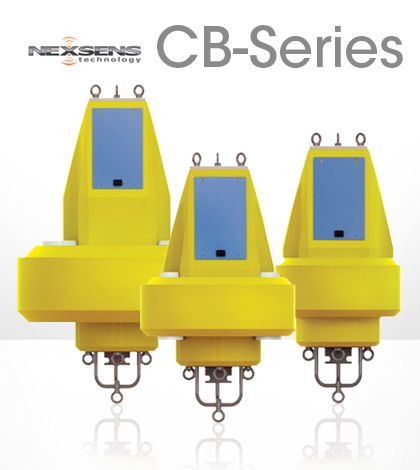NexSens CB-Series coastal buoys offer flexibility in monitoring system design

A lot of thought goes into the right combination of water quality sensors for a monitoring project. But the platform that supports them – the buoy – is just as important. With that in mind, NexSens Technology has released three new buoy models – the CB-200, CB-400 and CB-800.
“NexSens takes a slightly different approach to buoy designs by starting with a submersible data logger and building a floating package around it,” said Paul Nieberding, product manager.
Other buoys on the market generally offer a weatherproof or waterproof instrument well that houses data logger and sensor terminal connections. The advantage to having a completely submersible data logger, Nieberding said, is that the system can withstand a full submersion. Another is that the sensors aren’t wired in, but instead connected via submersible connectors that plug into NexSens’ submersible data loggers.
The number in each buoy’s name indicates its buoyancy in pounds. The CB-200, with the lowest buoyancy, is ideal for smaller boats and can be deployed by a single person. Its small size and low cost, Nieberding said, make it well-suited for small sensor payloads or for inclusion in dense buoy networks.
The CB-400 has a larger center float for added stability and includes three sensor through-ports with 4 inch female NPT threads on the bottom. “This allows for deployment pipes and other mounting mechanisms to be added as need,” Nieberding said.
The CB-800 is the next step up, and is best-suited for large and complex sensor payloads,he said. Each of the through-ports on the CB-800 can accommodate a battery pack, bringing the total possible power to 34 amp-hours.
“The new CB-Series buoy designs incorporate some of the best features of the NexSens data buoy lines that have evolved over the years,” said Nieberding.

Those include unbreakable solar panels, a stainless steel construction, rechargeable battery packs and a modular design that lets customers upgrade to larger or smaller buoys by simply purchasing an extra center float.
“The line offers greater flexibility in system design,” said Nieberding.
Many common sensors used with the buoys include temperature strings, multi-parameter sondes, Doppler current meters, weather stations, depth sonar and wave sensors. Accessories like beacons, instrument cages and ballast weights are also an easy addition.
“Our engineers have been involved with many buoy deployments over the years, and we listen very closely to customer feedback,” said Nieberding. “The sensor through-ports, unbreakable solar panel modules and locking cap mechanisms have all been a result of direct feedback from customers.”
Over time, the CB-Series buoys are very low maintenance. Nieberding says a rugged polymer skin that coats each buoy is designed for years of use. The bright, yellow color fades very little over the long-term and the largest maintenance component usually comes from the sensors deployed on the buoys.
Image: NexSens CB-200 deployed near a Pennsylvania dam (Credit: Mike Voellmecke)





Harold
September 3, 2017 at 4:44 pm
Hello, I am writing from Panama, I would like to know more about the CB-Series product.
Our project consists of a thermoelectric system with seawater cooling system. We are committed to measuring the temperature in the area of discharge in real time, for this we seek that the communication of data is via radio or any other method of lower cost.
If you can advise me on this topic.
Thank you very much
Harold.
Nate Christopher
September 12, 2017 at 4:56 pm
Hi Harold. Please contact customercare@fondriest.com for more information on the CB-Series to see if they’re right for your project.